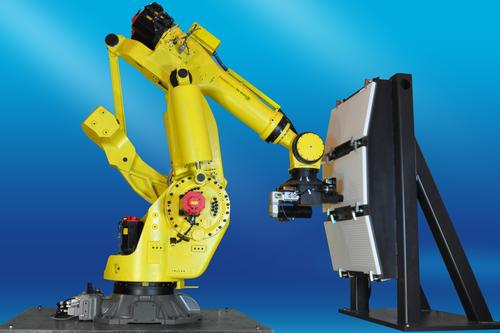Robotic Advances in Aerospace Manufacturing
April 4, 2013

The size and complexity of aerospace manufacturing processes is challenging industrial robot makers to respond with new solutions that integrate the precision of CNC technology, adaptive control, and intelligent use of feedback such as force sensors and secondary encoders. Added control sophistication is making it possible not only to address difficult-to-automate manual processes, but also to achieve accuracies and repeatability not normally associated with industrial robots.
"A major development with robotic systems, because of the unique requirements posed by the aerospace industry, is adding new robotic elements to support advanced manufacturing needs," Chris Blanchette, national account manager for FANUC Robotics America, told Design News. "This includes high accuracy tools using secondary encoders and robotic mechanical arms that are more rigid, so they can maintain accuracy while exerting force against the part and interfaces to vision systems, making it possible to get data and create a more adaptive process."

One of the fundamental reasons aerospace manufacturing is requiring advanced robotic applications is an inherent need to work with very large parts. Work cells can be 30 ft to 40 ft long and several stories high, hardly conducive to a robotic workspace, which is normally very small. The result is that some of the robots are being put on rails or implemented using gantries, which adds additional elements of complexity to the systems, especially if there is a high requirement for system accuracy.
"Supporting this manufacturing growth is driving the need for advanced robotic solutions, but another aspect is the materials being used," Blanchette told us, going on to say:
To assemble a car using a carbon fiber composite material for an automotive body panel, for example, the panels are put together, but normally there isn't a need to inspect them. No one will die in a crash from a crack in a body panel. It's a quality defect, not a safety defect.
But if there is a crack in an airplane panel, people can die as a result. So even if the automotive manufacturers are migrating toward using the same materials and processes, the requirements are different. In aerospace, there is a need for 100 percent inspection, so there is a new application that robots haven't really done before.
The requirements of the aviation world are driving the technology developments and trends of new robotic applications. Robot manufacturers and integrators are developing new ways to integrate those requirements.
Sealing and dispensing
Blanchette said there are a series of different trends and developments that are driving robotics-industry manufacturing technology for aerospace and defense applications. For the past two years, drilling and fastening were the fastest growing application areas using robotics automation. But now the trend has shifted to sealing and dispensing.
"What the aerospace companies are looking to do is eliminate manual processes that take a lot of production time," said Blanchette. "One challenge is that the designs are using materials which have a very short usable life, especially in applications such as sealing wings that are also full of fuel."
The primary goal for the automation is to save time because of throughput issues, as aerospace manufacturers are finding that demand is exceeding their ability to produce. In order to increase capacity using the same manufacturing methods used in the past, there would be a requirement to add real estate to the production facility, and the space required for these operations would be quite large. Since it is difficult to be globally competitive using this model, manufacturers are looking to automate some of these processes that are holding up production rates.
About the Author(s)
You May Also Like



